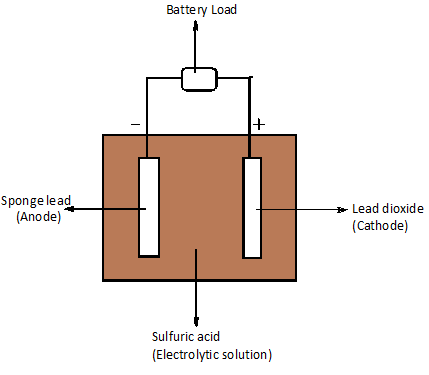Answer
383.1k+ views
Hint: As we know that the lead acid battery will have two electrodes and an electrolytic solution. The electrodes present in lead acid batteries are lead and lead dioxide.
Complete step by step answer:Lead acid batteries have a small energy-to-volume ratio and a very low energy-to-weight ratio; its ability to supply high contents reveals that the cell has a large power-to-weight ratio. Lead-acid batteries are categorized by secondary batteries. The chemical reactions, which occur in secondary cells, are reversible.
The commercial forms of lead acid batteries consist of six (or) twelve lead storage cells linked together.
Lead storage batteries are otherwise called lead-acid batteries. It is a secondary voltaic cell. The anode is made up of spongy porous lead and the cathode is made up of lead dioxide. The electrolyte used is sulfuric acid.
The active materials present on the plate of the battery (electrodes) are lead and lead dioxide. They react with sulfuric acid (electrolyte) to form lead sulfate. The formed lead sulfate is in amorphous state, finely divided and when the battery recharges it again forms lead, lead dioxide and sulfuric acid.

Lead acid batteries are used in large backup power supplies for telephone and compound centers, grid energy storage and as emergency lighting and to power sump pumps in power failure.
Therefore, the option (A) is correct.
Note:As we that lead storage batteries are cost efficient. They have low internal impedance and are tolerant to overcharging. They are also heavy and bulky with a cycle life of 300 to 500 cycles. There are varieties of lead acid batteries such as lead calcium battery, lead antimony battery etc.
Complete step by step answer:Lead acid batteries have a small energy-to-volume ratio and a very low energy-to-weight ratio; its ability to supply high contents reveals that the cell has a large power-to-weight ratio. Lead-acid batteries are categorized by secondary batteries. The chemical reactions, which occur in secondary cells, are reversible.
The commercial forms of lead acid batteries consist of six (or) twelve lead storage cells linked together.
Lead storage batteries are otherwise called lead-acid batteries. It is a secondary voltaic cell. The anode is made up of spongy porous lead and the cathode is made up of lead dioxide. The electrolyte used is sulfuric acid.
The active materials present on the plate of the battery (electrodes) are lead and lead dioxide. They react with sulfuric acid (electrolyte) to form lead sulfate. The formed lead sulfate is in amorphous state, finely divided and when the battery recharges it again forms lead, lead dioxide and sulfuric acid.

Lead acid batteries are used in large backup power supplies for telephone and compound centers, grid energy storage and as emergency lighting and to power sump pumps in power failure.
Therefore, the option (A) is correct.
Note:As we that lead storage batteries are cost efficient. They have low internal impedance and are tolerant to overcharging. They are also heavy and bulky with a cycle life of 300 to 500 cycles. There are varieties of lead acid batteries such as lead calcium battery, lead antimony battery etc.
Recently Updated Pages
Basicity of sulphurous acid and sulphuric acid are

Three beakers labelled as A B and C each containing 25 mL of water were taken A small amount of NaOH anhydrous CuSO4 and NaCl were added to the beakers A B and C respectively It was observed that there was an increase in the temperature of the solutions contained in beakers A and B whereas in case of beaker C the temperature of the solution falls Which one of the following statements isarecorrect i In beakers A and B exothermic process has occurred ii In beakers A and B endothermic process has occurred iii In beaker C exothermic process has occurred iv In beaker C endothermic process has occurred

What is the stopping potential when the metal with class 12 physics JEE_Main

The momentum of a photon is 2 times 10 16gm cmsec Its class 12 physics JEE_Main

How do you arrange NH4 + BF3 H2O C2H2 in increasing class 11 chemistry CBSE

Is H mCT and q mCT the same thing If so which is more class 11 chemistry CBSE

Trending doubts
Difference Between Plant Cell and Animal Cell

Difference between Prokaryotic cell and Eukaryotic class 11 biology CBSE

Fill the blanks with the suitable prepositions 1 The class 9 english CBSE

Change the following sentences into negative and interrogative class 10 english CBSE

Give 10 examples for herbs , shrubs , climbers , creepers

Fill the blanks with proper collective nouns 1 A of class 10 english CBSE

Select the word that is correctly spelled a Twelveth class 10 english CBSE

How fast is 60 miles per hour in kilometres per ho class 10 maths CBSE

What organs are located on the left side of your body class 11 biology CBSE



